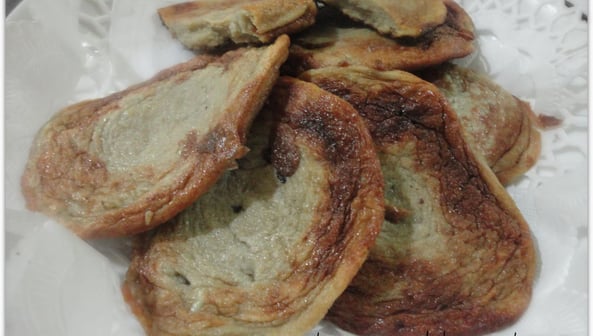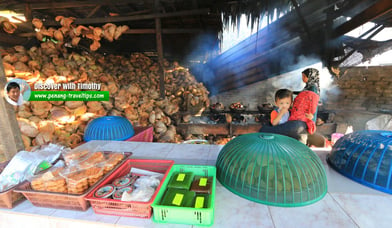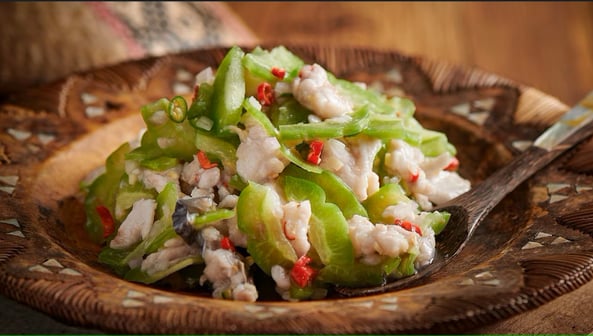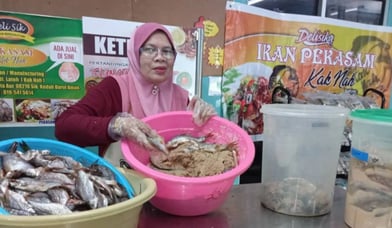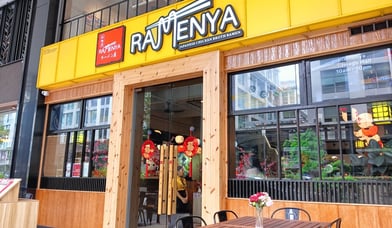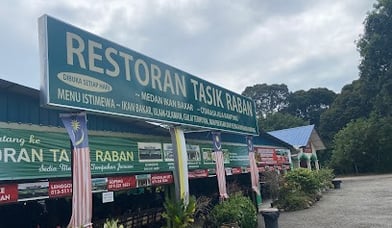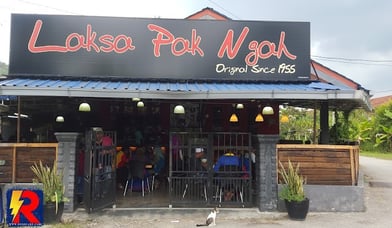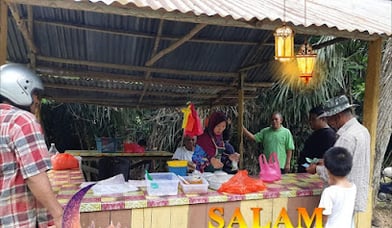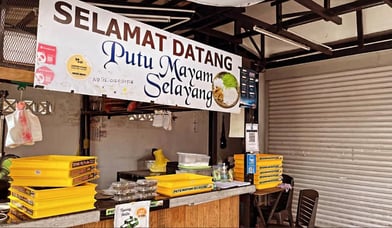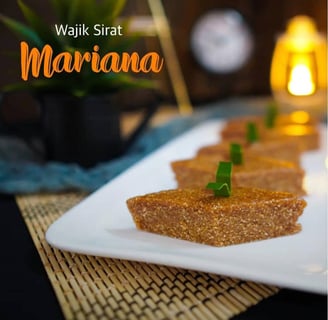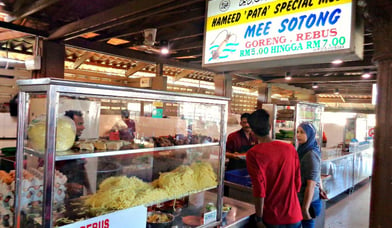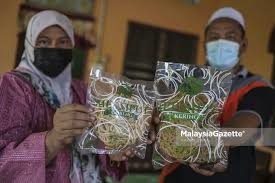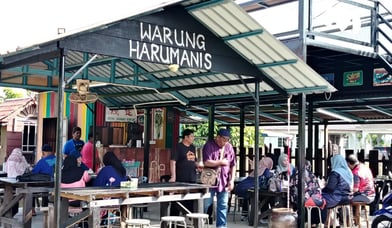Exploring the Diversity of Malaysia's Culturally Rich Traditional Cuisine
Traditional Malaysian cuisine is a cultural heritage that reflects the history and natural resources. Each dish has a unique story that is passed down from generation to generation, making it an important part of a region's identity. Let's explore the deliciousness and meaning behind each recipe.
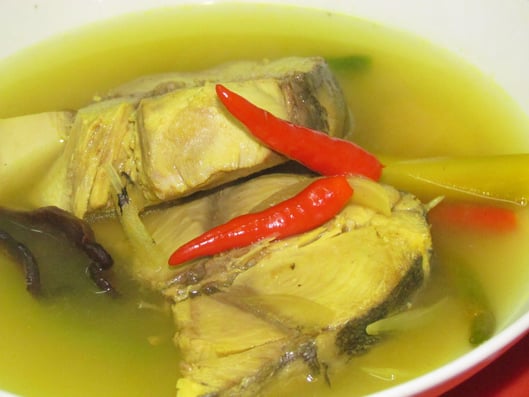

IKAN SINGGANG
RECIPES
HISTORY
Ikan Singgang is a traditional Terengganu cuisine that originates from the maritime culture of the fishing community. It has been around for hundreds of years, passed down from generation to generation due to its simple and nutritious way of preparation. This cuisine was influenced by Indonesian traders and remained permanent with basic recipes such as turmeric, garlic, sour flakes, and salt. The specialty of Ikan Singgang Terengganu is its simplicity without the use of galangal or lemongrass, making it a healthy dish that is often enjoyed with side dishes and budu.
Ingredients:
1 mackerel/cob/selayang (cut and cleaned)
2 cloves garlic (tapped)
1 inch live turmeric (finely ground) or 1 teaspoon turmeric powder
2 slices sour flakes
2 cups water
1 tsp salt
1 teaspoon sugar (optional)
3-4 chili peppers (optional, for spicy flavor)
How to Prepare:
1. Put the water in a saucepan along with the garlic, turmeric, and sour flakes. Bring to a boil.
2. Add the fish and let it simmer over medium heat for 10-15 minutes until the fish is cooked through.
3. Add salt and sugar to taste. If you like it spicy, add the chili peppers.
4. Stir gently and let it sit for a while before turning off the heat.
5. Serve hot with white rice, ulam-ulaman, and budu for a traditional taste of Terengganu
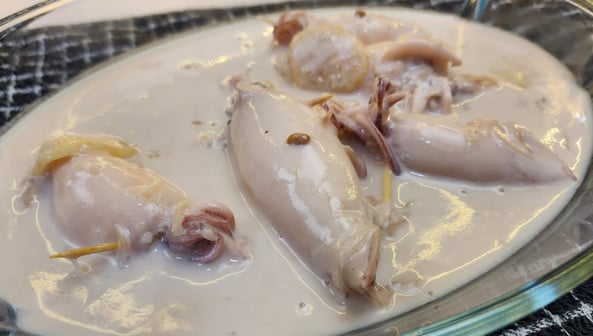

Ketupat Cuttlefish
RECIPES
HISTORY
Ketupat Sotong is a traditional dish from Terengganu and Kelantan that originated from the fishing community. This dish is unique in that it uses squid as a "package" for glutinous rice cooked with coconut milk, resulting in a sweet fatty flavor. Influenced by the Malay culture that likes to use coconut milk in cooking, it is often served in feasts and is part of the East Coast's culinary heritage.
Ingredients:
5-6 medium-large squids (clean, remove soft bones)
1 cup glutinous rice (soak for 2-3 hours, drain)
1 cup concentrated coconut milk
2 tbsp Melaka sugar (finely chopped)
1 tsp salt
2 pandan leaves (concluded)
2 skewers or toothpicks (for pinning cuttlefish)
How to Prepare:
1. Clean the cuttlefish, remove the ink and head, but do not remove the tentacles.
Prepare the glutinous rice
2. Mix the soaked glutinous rice with a pinch of salt.
Put the glutinous rice in the squid body (don't overfill it as the glutinous rice will expand).
3. Use a skewer or toothpick to pin the squid head so that the glutinous rice does not come out.
4. Put the squid in a pot with coconut milk, Melaka sugar, salt, and pandan leaves.
5. Cook over medium heat until the squid and glutinous rice are fully cooked (about 20-30 minutes).
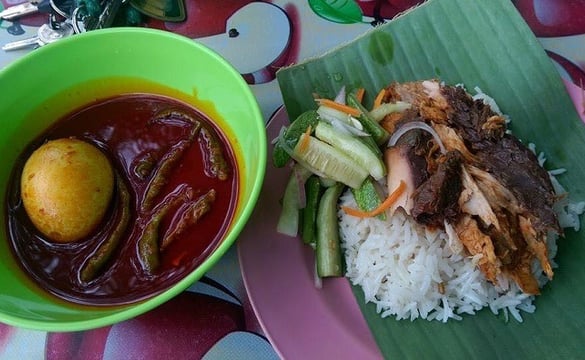

NASI DAGANG
RECIPES
HISTORY
Nasi Dagang is an iconic traditional dish from the states of Terengganu and Kelantan, which is often enjoyed as a breakfast or special dish. Origin & Name The name "Nasi Dagang" is said to have originated from the custom of traders and fishermen who bring this food as a provision because it is durable and filling. It is believed to have existed since the time of the Malay Sultanate when maritime trade flourished on the East Coast. The uniqueness of Nasi Dagang The rice used is a mixture of ordinary rice and glutinous rice, cooked with coconut milk so that it has a soft texture but is not too sticky. Served with spice-rich cod fish curry, as well as pickled cucumbers and radishes as a complement.
Rice Ingredients:
3 cups Nasi Dagang rice (soaked 4-6 hours)
1 cup concentrated coconut milk
1 tsp salt
1 tsp herbs
3 cloves of shallots (sliced)
1 pandan leaf (summed)
How to Cook Rice:
1. Steam the rice until half cooked (15-20 minutes).
2. Remove and mix with coconut milk, salt, onion, and ginger.
3. Resteam until the rice is cooked perfectly.How to Prepare:
1. Put the water in a saucepan along with the garlic, turmeric, and sour flakes. Bring to a boil.
2. Add the fish and let it simmer over medium heat for 10-15 minutes until the fish is cooked through.
3. Add salt and sugar to taste. If you like it spicy, add the chili peppers.
4. Stir gently and let it sit for a while before turning off the heat.
5. Serve hot with white rice, ulam-ulaman, and budu for a traditional taste of Terengganu
Cod Fish Curry Ingredients
1 cod (chopped, boiled with sour flakes).
3 tbsp fish curry spice.
1 tbsp ground chili.
1 lemongrass stalk (dotted).
3 cloves shallots & 2 cloves garlic (grinded)
1 inch ginger & galangal (ground)
1 cup concentrated coconut milk
1 piece of gelugur acid
Salt & sugar to taste
How to Cook Gulai:
1. Sauté the ground ingredients, curry spices, and ground chili until the oil breaks.
2. Add coconut milk, lemongrass, and sour flakes, let it boil.
3. Add the fish and simmer until the sauce thickens and serve.
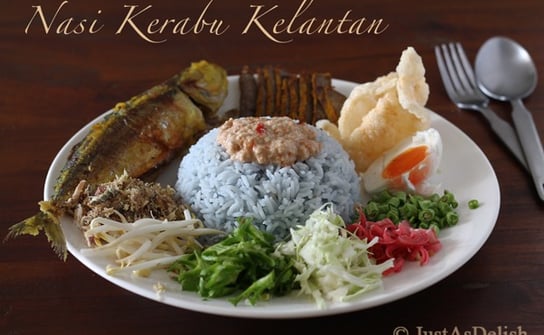

NASI KERABU
RECIPES
HISTORY
Nasi Kerabu originated from Kelantan and was influenced by Thailand. It is known for its blue color obtained from the telang flower. Originally, this dish was prepared for special occasions but is now a popular daily meal.
There are several types of Nasi Kerabu such as blue, yellow (use turmeric), and white (without color). This dish is usually served with ulam-ulaman, budu, coconut sauce, salted eggs, and side dishes such as ayam percik or fried fish.
The uniqueness of Nasi Kerabu lies in the combination of fatty, sweet, and spicy flavors, symbolizing the food culture of the people of Kelantan. Now, it is not only popular in Malaysia but also internationally known.
Rice Ingredients:
For the Blue Rice:
2 cups rice
1 cup butterfly pea flower water (boil flowers in water and strain)
2 pandan leaves (knotted)
1/2 tsp salt
For the Coconut Sambal:
1 cup grated coconut (toasted)
1 tbsp shrimp paste (belacan)
2 shallots (chopped)
2 red chilies (chopped)
1 tsp palm sugar
For the Spiced Gravy (Kuah Tumis):
1 cup coconut milk
2 tbsp fermented fish sauce (budu)
3 shallots (blended)
2 cloves garlic (blended)
1 stalk lemongrass (blended)
2 red chilies (blended)
1 tbsp oil
For the Side Dishes:
Grilled chicken, fried fish, or grilled beef
Fresh herbs (kesum leaves, pegaga, long beans, cucumber)
Salted eggs
Instructions:
1. Cook the rice with butterfly pea flower water, pandan leaves, and salt until fluffy.
Prepare coconut sambal by toasting grated coconut and blending it with shrimp paste, shallots, chilies, and palm sugar.
Make the gravy by sautéing blended ingredients in oil, then adding coconut milk and fermented fish sauce. Simmer until thick.
Prepare the side dishes by grilling or frying the protein of your choice.
Assemble the dish by serving blue rice with coconut sambal, spiced gravy, fresh herbs, salted egg, and fish crackers.
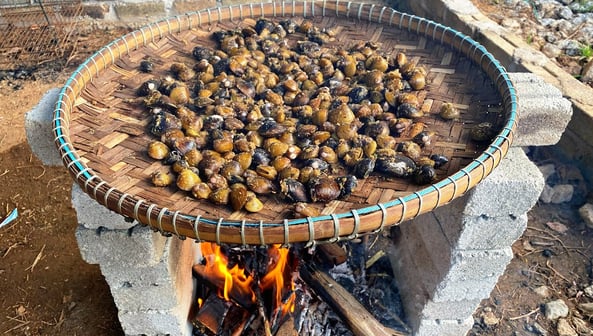

ETOK
RECIPES
HISTORY
Etok, a small freshwater clam, has been a part of Kelantanese cuisine for generations. It is believed to have been consumed by locals for centuries, as Kelantan is rich in rivers and lakes, providing an abundant supply of etok.
Traditionally, Kelantanese fishermen and villagers collected etok from riverbanks and used simple preservation methods like salting and drying to prolong its shelf life. Over time, grilled (salai) and boiled etok became popular preparation methods, making it a well-loved snack.
Today, etok remains an iconic delicacy in Kelantan, commonly sold at local markets, roadside stalls, and especially in Pasar Siti Khadijah. It represents the strong connection between Kelantanese culture and its natural river resources, making it a timeless culinary tradition.
Preparation Method
Cleaning: Etok is soaked to remove mud and dirt.
Marination: Mixed with salt, lemongrass, garlic, and chili for extra flavor.
Cooking Methods:
Grilling (Salai): Slowly roasted over charcoal for a smoky aroma.
Boiling: Cooked in seasoned water to absorb flavors completely.
Best Way to Enjoy Etok
Eaten by sucking the meat out of the shell.
Often paired with hot tea or enjoyed as a light snack.
Commonly found in Pasar Siti Khadijah and other Kelantanese markets




Location
1 . Nasi dagang Kak Pah Batu Burok
3 . Nasi Dagang Warisan Batu Buruk
2 . Nasi Dagang Tepi Kubur Kg Atas Tol
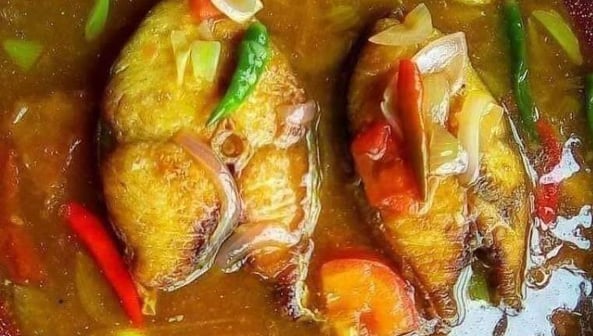

Sour Cooked Fish
RECIPES
HISTORY
Masak asam or cuka Kedah is a traditional dish influenced by Siamese cuisine due to Kedah's historical ties with Thailand. It uses local ingredients such as fresh fish, asam keping (dried tamarind slices), turmeric, and lemongrass, making it a simple yet popular village dish. The name "masak asam" or "cuka" refers to the use of acidic ingredients like asam keping or vinegar to create a tangy flavor. This dish reflects the food culture of Kedah, which is simple yet rich in taste.
Ingredients:
500g fish (mackerel, snapper, or any preferred fish)
3 shallots (sliced)
2 garlic cloves (sliced)
2 stalks lemongrass (bruised)
1-inch ginger (sliced)
2 tbsp chili paste
1 tsp turmeric powder
1 piece asam keping (dried tamarind slice)
2 tomatoes (quartered)
5-6 okras (optional)
1 tbsp sugar
Salt to taste
500ml water
Instructions:Heat some oil in a pot and sauté shallots, garlic, ginger, and lemongrass until fragrant.
Add chili paste and stir until the oil separates.
Stir in turmeric powder, then pour in water, asam keping, salt, and sugar. Let it simmer.
Add the fish and let it cook until tender.
Finally, add tomatoes and okra. Cook for a few minutes until slightly softened.
Turn off the heat and serve hot with steamed rice.
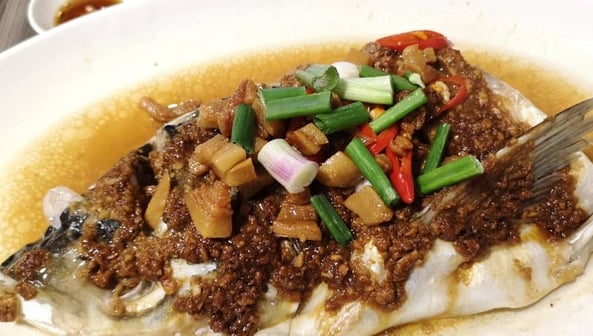

Sour Cooked Fish
RECIPES
HISTORY
Ikan Pekasam is a traditional fermented fish dish from Kedah, Perlis, and Perak, originating as a preservation method for freshwater fish using salt and fried rice for natural fermentation. Influenced by Siamese and Nusantara cuisine, it shares similarities with Thailand’s Pla Som and Indonesia’s Bekasam. Historically, it was a staple among farmers and fishermen to store excess fish for long-term use. Once homemade, it is now commercially produced with modern variations adding herbs and spices. A symbol of Kedah’s culinary heritage, it remains popular, typically fried and served with rice, onions, and chilies. 🌾🐟🔥
Ingredients:
500g freshwater fish (tilapia, catfish, or snakehead fish)
100g salt
200g rice (fried and ground)
1 tbsp sugar
Water for soaking
Instructions:Clean the fish – Remove scales, guts, and wash thoroughly. Pat dry.
Salt the fish – Coat the fish evenly with salt and let it sit for 24 hours.
Soak in water – Rinse the fish to remove excess salt and soak in clean water for a few hours.
Fermentation – Coat the fish with fried, ground rice and sugar, then place it in an airtight container.
Store for 5-7 days – Keep in a cool, dark place to ferment. The longer it ferments, the stronger the flavor.
Ready to cook – Once fermented, deep-fry or pan-fry the fish and serve with rice, onions, and chilies
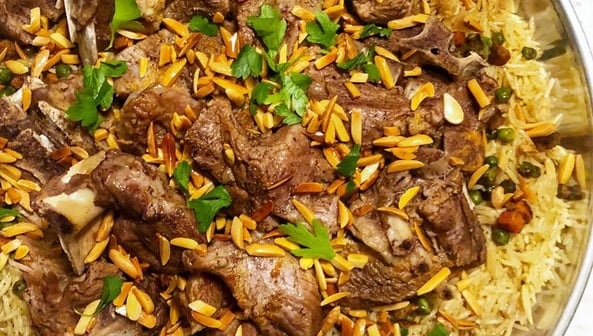

Sour Cooked Fish
RECIPES
HISTORY
Nasi Daging Kedah is a traditional dish from Kedah, often served during special occasions. Influenced by Arab and Indian cuisine, it incorporates spices like cloves and cinnamon, reflecting historical trade connections. Kedah’s strong agricultural background made this dish popular among farmers due to its hearty and simple preparation. Its unique feature is Air Asam, a tangy dipping sauce that enhances the dish’s flavor. Originally cooked over firewood, it has evolved with modern techniques but remains a symbol of togetherness in Malay culture, especially during celebrations and feasts. 🍛
Ingredients:
For the Rice:
2 cups basmati rice (washed and drained)
500g beef (preferably with some fat)
1 large onion (sliced)
3 cloves garlic (minced)
1-inch ginger (sliced)
1 cinnamon stick
2 star anise
3 cloves
3 cardamom pods
2 tbsp ghee or butter
3 cups beef broth (from boiling the beef)
1 tsp salt
1 tsp sugar
For the Air Asam (Tangy Dipping Sauce):
2 tomatoes (diced)
1 red onion (sliced)
2 bird’s eye chilies (chopped)
2 tbsp tamarind juice
1 tbsp soy sauce
1 tbsp sugar
1/2 tsp salt
Instructions:
Step 1: Prepare the Beef and Broth
Boil the beef with salt, ginger, and garlic until tender (about 45 minutes).
Once cooked, remove the beef and slice it thinly. Keep the beef broth for cooking the rice.
Step 2: Cook the Rice
Heat ghee in a pot and sauté onions, garlic, ginger, cinnamon, star anise, cloves, and cardamom until fragrant.
Add the rice and stir well to coat with the spices.
Pour in the beef broth, add salt and sugar, then cover and cook until the rice is fluffy.
Step 3: Make the Air Asam
In a bowl, mix all air asam ingredients and let it sit for 10-15 minutes for the flavors to blend.
Step 4: Serve
Plate the rice with sliced beef on top.
Serve with air asam and a side of fresh vegetables
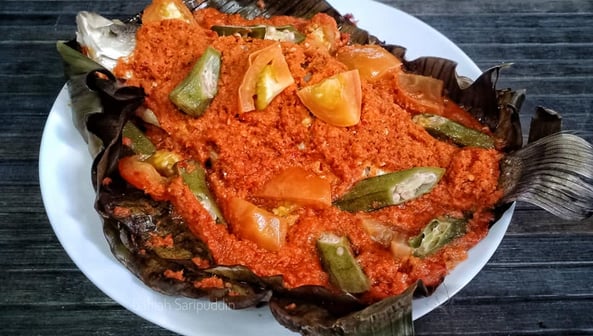

Portuguese grilled fish
RECIPES
HISTORY
Ikan Bakar Portugis in Melaka originated from the Kristang community, who are descendants of the Portuguese colonizers and the local Malay population since the Portuguese colonized Melaka in 1511. This dish reflects a fusion of European and local culinary cultures, especially in terms of the use of spices such as chili, garlic, belacan, and turmeric. Ikan Bakar Portugis usually uses fresh sea fish such as stingray or kembung, which is marinated with a special sambal, then wrapped in banana leaves and grilled over charcoal. This dish was popularized in the Portuguese settlement area of Ujong Pasir, Melaka, known as the Portuguese Settlement. It is here that visitors can experience the deliciousness of traditional Kristang cuisine that is spicy, spicy and full of flavor, making Ikan Bakar Portugis one of the main culinary attractions in Melaka.
Main ingredients:
Fish (e.g. stingray, mackerel, kembung or jenahak)
Tasam water (squeezed from tasam and water)
Cooking oil (for stir-frying)
Enough water
Kesum leaves
Kantan flowers (halved – optional)
Tomatoes (halved – optional)
Okra/bendi (chopped – optional)
Salt and sugar to taste
Grind Ingredients:
Dried chili (boiled and ground – for spicy sauce)
Red onion
Garlic
Ginger
Raw turmeric or turmeric powder
Belacan (a little – for umami flavor)
Instructions:
Cooking steps:
1. Blend all the sambal ingredients until smooth.
2. Heat the oil in a wok, and stir-fry the blended ingredients until the oil separates and the aroma increases. Add salt, sugar, and tamarind water. Cook until the sambal thickens.
3. Place the banana leaves on a tray or aluminum foil. Brush a little oil on the leaves.
4. Place the fish, then pour the sambal over the fish until it is evenly distributed. Wrap the fish with the banana leaves.
5. Grill on a flat pan, grill, or in the oven for about 20–30 minutes, depending on the size of the fish. If using charcoal or embers, it will be even more fragrant!
6. When cooked, serve hot with white rice and sambal belacan limau.
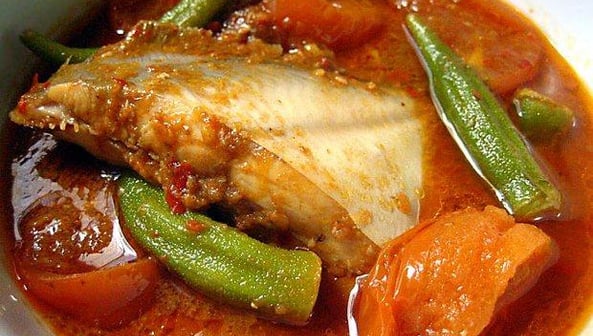

Asam Pedas Melaka
RECIPES
HISTORY
Asam Pedas Melaka, is a popular traditional dish in the historic state. Just mention asam pedas, surely everyone knows the connection between this dish and the state of Melaka. This food is one of the must-try menus that you must try if you visit this state. Asam Pedas is a traditional dish that originated in Indonesia, especially in the Riau Islands and the Malay Archipelago. This dish is famous for its sour and spicy taste produced from a mixture of chili paste and tamarind juice. This Asam Pedas dish has been created as a result of the influence of various cultures, including Thai and Indian cuisine, as well as spices brought by Arab traders who passed through the area. In Malaysia, Asam Pedas is usually served with fish, while in Indonesia, it is more often used with beef or buffalo meat.
Main ingredients:
1 fish (type of fish depends on your taste)
4 tablespoons cooking oil
4 shallots
5 garlic cloves
1 large onion
1 inch ginger
1 inch fresh turmeric
a little black pepper
a little cumin
a little cumin
a little fenugreek
15 to 20 dried chilies (ground)
1 bowl tamarind water
3 lemongrass stalks (spiked)
a little melaka sugar
a little belacan
kaffir lime leaves
bendi (depending on taste)
2 cups water (depending on need)
Instructions:
1. Sauté the ground ingredients in oil until fragrant and the oil separates (about 5–10 minutes).
2. Add tamarind juice and a little water. Let it boil.
3. Add kesum leaves, kantan flowers, and a little sugar and salt.
4. Add the fish and let it cook in the boiling broth.
5. Finally, add the okra and tomatoes. Cook briefly until the vegetables are soft.
6. Taste the broth — balance the sour, spicy and slightly sweet flavors.


Kuih Keria Melaka
RECIPES
HISTORY
Kuih Keria Melaka
The origin of kuih keria is closely linked to the Malay community in Malaysia, especially in the East Coast states such as Melaka and Kelantan, but the most famous version now is Kuih Keria Gula Melaka from Melaka, especially in the Limbongan area. Kuih keria originated from the idea of the ancient community who wanted to produce simple cakes using easily available basic ingredients such as sweet potatoes. Sweet potatoes are mashed, shaped like donuts, and fried until crispy on the outside but soft on the inside. Originally, kuih keria was only coated with white sugar, but then the Melaka community created a unique version with melted gula Melaka (coconut sugar cooked until thick) — making this cake more fragrant, fatty, sweet and shiny. Kuih keria is not only a traditional dish for afternoon tea or celebrations, but has also become a Melaka food icon that is often sought after by tourists, especially at the legendary stalls around Jalan Limbongan. The specialty of this cake lies in the combination of the soft sweet potato flavor and the sticky and fragrant gula Melaka coating.
Main ingredients:
Sweet potato (orange or yellow sweet potato is better) – boiled and mashed
Wheat flour – enough to knead the dough
Cooking oil – for frying
Ingredients for coating:
Melaka sugar – cut into small pieces or finely chopped
A little water – to dissolve the sugar while cooking
Panda leaves (optional) – to make the sugar fragrant
Instructions
Step 1: Prepare the dough
1. Boil the sweet potato until soft, then mash until smooth.
2. Mix the sweet potato with wheat flour and a pinch of salt. Knead until the dough is soft and not sticky. Add flour little by little - not too much so that the cake is not hard.
3. Shape the dough into small balls, then punch a hole in the middle (like a donut).
Step 2: Fry
Heat the oil over medium heat. Fry the keria cakes until golden brown. Remove and drain the oil.
Step 3: Prepare the gula Melaka coating
Add the gula Melaka, white sugar, water and pandan leaves to the pan. Cook until the sugar dissolves and becomes thick and foamy (almost viscous sign).
Turn off the heat, add the fried keria cakes to the pan. Mix quickly until the cakes are completely coated and the sugar begins to harden on the surface of the cakes.
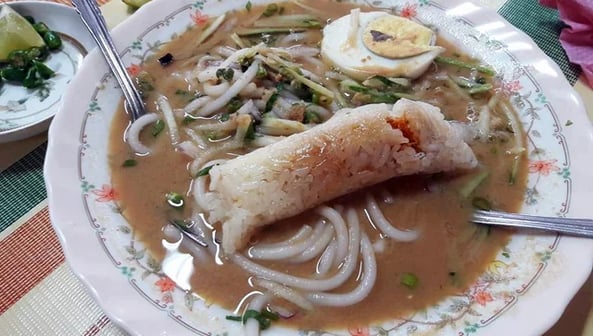

Laksa Kuala Perlis
RECIPES
HISTORY
Laksa Kuala Perlis
Kuala Perlis Laksa, also known as "laksa kola", is an iconic dish in Kuala Perlis. It is famous for its thick broth, made from fresh fish such as mackerel or selayang, and eaten with grilled glutinous rice.
Main ingredients:
- Rice Laksa
- Mackerel or selayang
- Bunga kantan, kesum leaves
- Dried chili, shallot, garlic, belacan
- Asam keping, galangal, lemongrass
- Cucumber, boiled egg, pineapple (as garnish)
Instructions
How to Cook
Boil the fish until cooked, separate the contents and grind it with the kantan flowers and kesum leaves.
Saute dried chilies, shallots, garlic, and belacan until fragrant.
Add the fish paste to the stir-fry, add enough water.
Add the asam keping, galangal, and lemongrass. Cook until the gravy thickens.
Serve the laksa with gravy, garnished with cucumber, boiled egg, and pineapple.
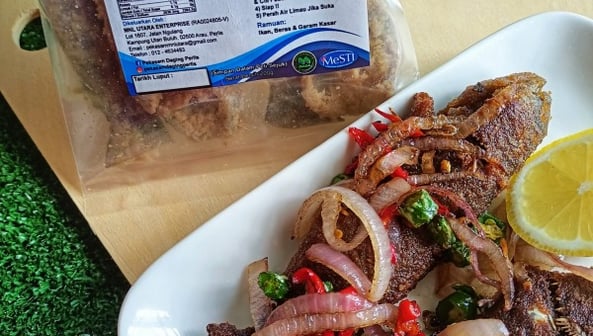

Pekasam Ikan Puyu
RECIPES
HISTORY
Pekasam Ikan Puyu
Pekasam is a traditional fermented food, popular in Perlis. Puyu fish is often used because of its suitable texture for the fermentation process.
Main ingredients:
Fresh puyu fish
Coarse salt
Rice (sangai and finely pounded)
Asam keping
Instructions
How to Cook
Clean the puyu fish, rub with coarse salt.
Arrange the fish in a container, sprinkle with sangai rice and place pieces of asam between the layers of fish.
Close the container tightly and marinate for 3-5 days in a cool place.
To serve, fry the pickled fish until crispy.
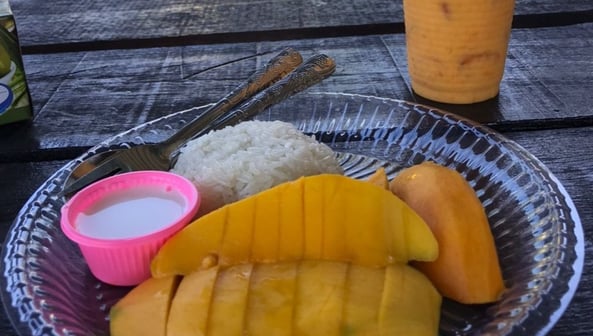

Pulut Harumanis
RECIPES
HISTORY
Pulut Harumanis
Pulut Harumanis is a dessert that combines glutinous rice with Harumanis mango, an iconic Perlis fruit that is only available in certain seasons.
Main ingredients:
Glutinous rice
Thick coconut milk
Salt and sugar
Harumanis mango (sliced)
Instructions
How to Cook
Soak the glutinous rice for 3 hours, then steam until cooked.
Cook the coconut milk with a little salt and sugar until boiling.
Mix the coconut milk into the cooked glutinous rice.
Serve the glutinous rice with slices of Harumanis mango.
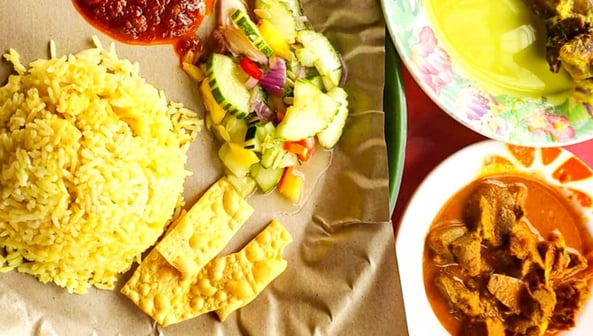

Nasi Beringin
RECIPES
HISTORY
Nasi Beringin
Nasi Beringin was a Johor court dish in the late 1890s, served to royals and palace guests.
Main ingredients:
Rice
Pandan leaves
Garlic, ginger
Spices
Butter.
Lemongrass
Coconut milk
Instructions
How to Cook
Saute garlic, ginger, lemongrass, and spices with butter until fragrant.
Add rice and mix well.
Add coconut milk and pandan leaves, cook until rice is cooked.
Serve with pickles, chicken curry, sambal, and boiled egg.
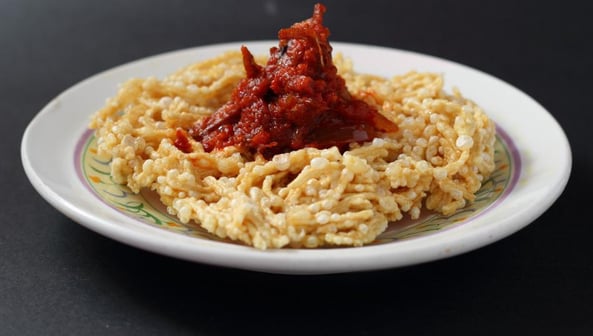

Mee Siput
RECIPES
HISTORY
Mee Siput
Mee Siput is a traditional snack from Muar, Johor, made from wheat flour dough shaped like a snail shell and fried until crispy.
Main ingredients:
Wheat flour
Water
Salt
Oil for frying
Instructions
How to Cook
- Knead the wheat flour with water and salt until it becomes a dough.
Roll out the dough and cut it lengthwise, then shape it into a spiral.
Dry the noodles until dry.
Fry in hot oil until crispy.
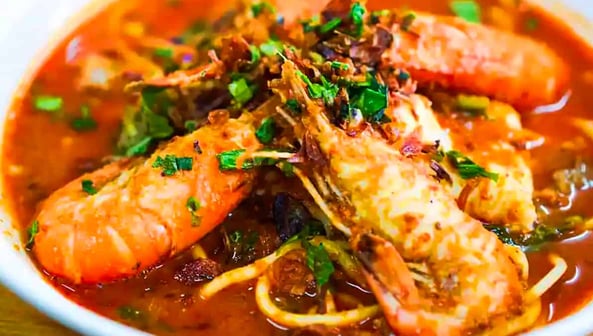

Mee Bandung Muar
RECIPES
HISTORY
Mee Bandung Muar
The word 'bandung' in its name comes from the meaning of the word which means 'double' or 'twin' or 'paired' where something is combined or mixed with something else.
Main ingredients:
Yellow noodles
Dried shrimp
Meat
Egg
Dried chili
Onion, garlic
Peanuts
Instructions
How to Cook
Sauté the onion and dried chili until fragrant.
Add the dried shrimp and meat, cook until tender.
Add water and ground peanuts, cook until the gravy thickens.
Boil the yellow noodles, drain, and serve with gravy and boiled eggs.
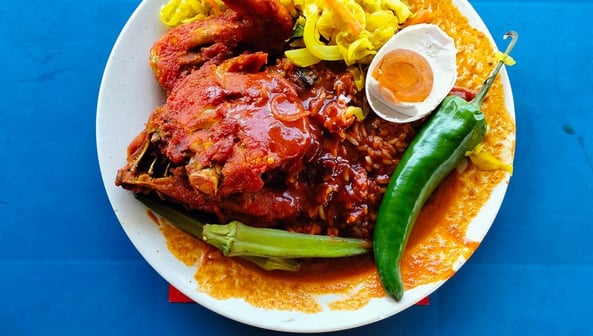

Nasi Kandar
RECIPES
HISTORY
Nasi Kandar
Nasi Kandar originated in Penang and was introduced by Tamil Muslim traders from India. It consists of white rice served with various types of curries and side dishes such as chicken, meat, squid, and vegetables.
Main ingredients:
White rice
Chicken/meat/fish curry
Vegetables (okran, cabbage)
Boiled eggs
Sambal
Instructions
How to Cook
1. Cook white rice until cooked.
2. Prepare various types of curries with appropriate spices.
3. Fry or boil side dishes such as chicken, meat, or fish.
4. Serve rice with side dishes and pour in enough curry sauce.
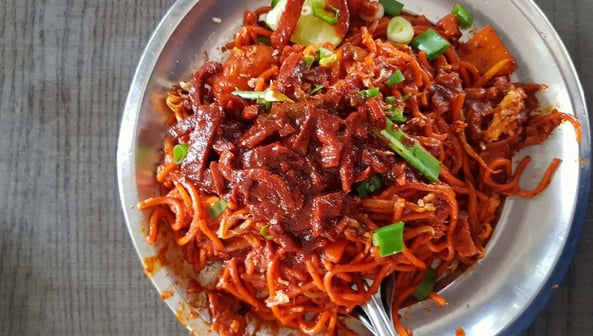

Mee Sotong
RECIPES
HISTORY
Mee Sotong
Mee Sotong is a popular dish in Penang known for its spicy red sauce and dried squid sambal.
Main ingredients:
Yellow noodles
Bean sprouts
Boiled eggs
Sweet potatoes
Dried squid sauce
Instructions
How to Cook
Boil the yellow noodles until soft and drain.
Boil the potatoes and cut into cubes.
Prepare the squid sauce by sautéing dried chilies, onions, and dried squid until cooked.
Serve the noodles with bean sprouts, boiled eggs, potatoes, and pour the squid sauce over them.
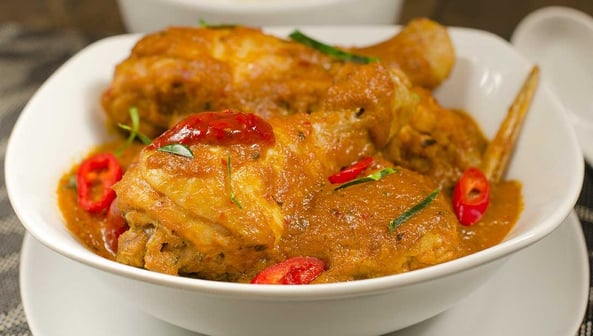

Kari Kapitan
RECIPES
HISTORY
Kari Kapitan
Mee Sotong is a popular dish in Penang known for its spicy red sauce and dried squid sambal.
Main ingredients:
Chicken
Coconut milk
Shallot, garlic, ginger
Lemongrass, galangal, turmeric
Dried chilies
Tamarind
Instructions
How to Cook
Sauté the ground ingredients (onion, ginger, galangal, turmeric, dried chili) until fragrant.
Add the chicken and mix well.
Add coconut milk and tamarind, cook until the chicken is tender and the gravy is thick.
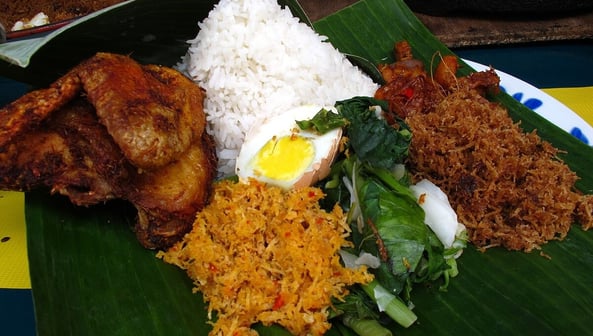

Nasi Ambeng
RECIPES
HISTORY
Nasi Ambeng
The origin of Nasi Ambeng (also spelled as nasi ambang) is closely linked to the Javanese people who migrated to Malaya, especially to states such as Selangor, Johor and Perak, since the 19th century.
This dish originated from the island of Java, Indonesia, and was brought with them by Javanese immigrants when they settled in Malaysia. In its country of origin, nasi ambeng is a traditional food served during kenduri awarah (meals for the dead), tahlil (tahlil) and Islamic religious ceremonies, similar to its use in Malaysia.
Main ingredients:
1. White rice (cooked as usual)
2. Chicken cooked in soy sauce
3. Javanese fried sambal
4. Coconut noodles
5. Javanese fried noodles
6. Bergedel (optional)
7. Fried dried fish (optional)
Instructions
How to Cook
Tempeh, tofu – fried & chopped
Suhun, fucuk, potatoes – soaked/cooked soft
4 shallots, 2 garlic cloves, 10 dried chilies – ground
Coconut milk, a little tamarind juice, salt, sugar
Method:
Stir-fry the ground ingredients until oil separates.
Add all ingredients and mix well. Add coconut milk and cook until dry.
Coconut Filing
Ingredients:
1 grated coconut
A little anchovies (pounded), shallots, garlic, dried chilies (stir-fried/ground)
Brown sugar, salt
Method:
Mix grated coconut with stir-fry ingredients, cook slowly until crisp and fragrant.
Javanese Fried Noodles (optional)
Yellow noodles fried with chili paste, tomatoes, mustard greens, bean sprouts, and a little sweet and spicy sauce.


Kuih Wajik Sirat
RECIPES
HISTORY
Kuih Wajik Sirat
Wajik Sirat Cake is a traditional Malay cake that comes from the influence of Javanese culture, especially among residents in states such as Selangor, Johor, and Melaka. The name "wajik" refers to the shape of the cake cut into pieces that resemble the shape of a diamond (rombic), while "sirat" means that this cake is covered or coated with brown sugar, nisan or gula Melaka which gives it a sweet and shiny taste. This cake is believed to have been brought by the Javanese community who migrated to Malaya in the 19th century and has since become part of the traditional cake heritage in Malaysia. It is usually prepared during feasts, engagements, weddings, and celebrations, as a symbol of prosperity, the sweetness of life and gratitude. The combination of the fat taste of coconut milk, glutinous rice, and natural sweets makes wajik sirat cake remain popular to this day.
Main ingredients
2 cups glutinous rice – soaked for 3–4 hours and drained
1 cup thick coconut milk
1 piece gula Melaka (approx. 200g) – cut into small pieces
1/2 cup granulated sugar (can reduce to taste)
1 pandan leaf – tied
A pinch of salt
Instructions
How to Cook
Steam the glutinous rice:
Steam the soaked glutinous rice for 30–40 minutes until fully cooked (soft and shiny). Set aside.
Cook the sugar syrup:
In a large wok or pot, melt the gula Melaka and granulated sugar with a little water and pandan leaves. Cook until dissolved and thickened (a little viscous).
Add the coconut milk and salt:
Pour the coconut milk and a pinch of salt into the sugar solution. Cook over medium heat until boiling and slightly thickened.
Add the steamed glutinous rice:
Add the cooked glutinous rice to the coconut milk and sugar mixture. Mix well until the glutinous rice absorbs all the liquid and becomes shiny, thick and sticky.
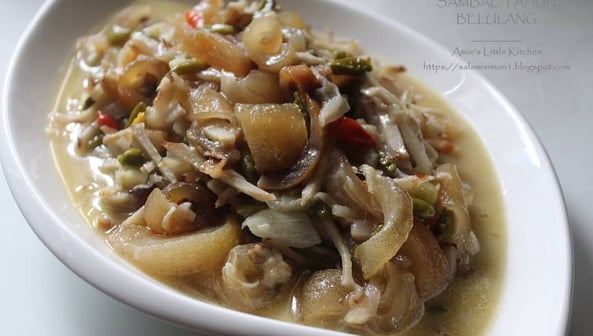

Sambal Taun Kulit lembu
RECIPES
HISTORY
Sambal Taun Kulit lembu
Sambal Taun Kulit Lembu is a traditional dish originating from the Javanese community in Malaysia, especially those living in areas such as Sabak Bernam (Selangor), Batu Pahat, and Pontian (Johor). The word "taun" is believed to come from the Javanese word meaning "year" or associated with the season, as this sambal is usually cooked in large quantities during festivals, feasts, or certain occasions such as the feast of the dead and Hari Raya.
This dish combines soft-boiled cow skin and cooked in a thick coconut milk sauce with chilies, onions, galangal and spices. The special feature of sambal taun is its rich, spicy, aromatic taste, and long-lasting due to the use of coconut milk that is cooked until it bursts into oil. In the past, it was also cooked in earthen pots or belanga, adding to the original and traditional taste.
Main ingredients
500g beef skin – boiled until tender, cut into small pieces
2 cups thick coconut milk
1 cup liquid coconut milk
10–15 chilies (depending on the level of spiciness)
5 shallots
3 garlic cloves
1 inch ginger
1 inch galangal
1 lemongrass stalk – pricked
1 turmeric leaf – chopped and knotted (if available)
Salt and sugar to taste
Oil for stir-frying
Instructions
How to Cook
Prepare the ingredients for the mixture:
Grind the chilies, shallots, garlic, ginger and galangal until smooth.
Stir-fry the spices:
Heat the oil and stir-fry the ingredients with lemongrass until fragrant and the oil separates.
Add the liquid coconut milk and beef skin:
Add the boiled beef skin and liquid coconut milk. Mix well and let it boil over medium heat.
Add the thick coconut milk and turmeric leaves:
When the gravy is a little dry, pour in the thick coconut milk and add the turmeric leaves. Stir gently so that the coconut milk does not break. Cook until the gravy becomes thick and shiny.
Season:
Add salt and a little sugar to taste. Continue cooking until the gravy is really thick and the beef skin absorbs the flavor.
Ready to serve:
Ready to serve: Serve with hot white rice, ulam, or sambal belacan if you like.
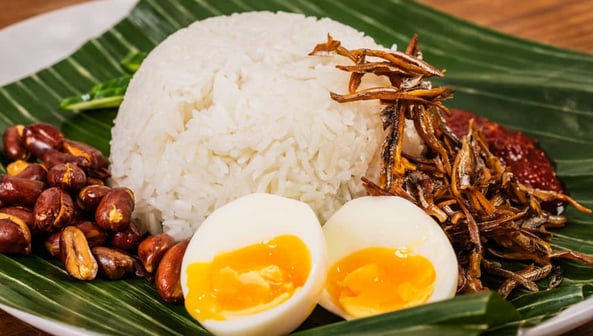

Nasi lemak
RECIPES
HISTORY
Nasi lemak
Nasi Lemak originated from the Malay community in Peninsular Malaysia, and is believed to have existed for centuries as a staple food for village communities. It is a combination of local ingredients such as rice, coconut milk, pandan leaves, anchovies, eggs and sambal, making it a complete and energy-rich dish.
Main ingredients
2 cups rice – washed and drained
1 ½ cups thick coconut milk
1 pandan leaf – knotted
1 tsp ginger – sliced (optional)
½ tsp salt
Enough water (if needed)
Instructions
How to Cook Rice:
1. Add rice, coconut milk, pandan leaves, salt and ginger to a pot or rice cooker.
2. Cook as usual until the rice is cooked and fully cooked.
3. Stir a little to loosen the rice and avoid lumps.
How to Cook Sambal:
1. Grind the dried chilies, garlic and shallots until fine.
2. Fry the ground ingredients in hot oil until the oil separates and the aroma increases.
3. Add tamarind, gula Melaka, salt, and a little water.
4. Cook until the sambal is thick, add sliced onions (if you like), and balance the flavors.
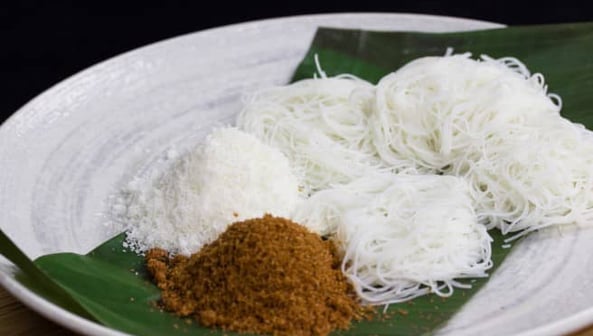

Putu Mayam
RECIPES
HISTORY
Putu Mayam
Putu Mayam is a traditional type of cake originating from South India, particularly from the Tamil community, and is known there as "Idiyappam". It is made from rice flour that is kneaded and pressed into fine noodles, then steamed. The cake was brought to Malaysia, Singapore, and Indonesia by Indian immigrants (mainly Tamils) in the 19th century, during the British colonial era, especially to work on plantations and as laborers.
In Malaysia, the name "Putu Mayam" is believed to have originated from Tamil influences, where "putu" refers to something that is steamed, and "mayam" may have been adapted from words related to its shape or method of preparation. However, this name has also undergone changes according to the local dialect.
Main ingredients
2 cups rice flour (choose good quality and fine)
1 cup boiling hot water
1/4 teaspoon salt
1 teaspoon cooking oil (to soften the dough)
Equipment:
Putu mayam mold or idiyappam press (like a muruku mold with fine holes)
Steamer and banana leaves or muslin cloth (for steaming mat)
Instructions
Prepare the dough:
Mix the rice flour and salt in a large bowl.
Add hot water little by little while kneading with a wooden spoon or your hands (be careful because it is hot).
Add oil and knead until it becomes a soft dough that does not stick to your hands.
Put into the mold:
Take a little dough and put it into the putu mayam mold.
Press the dough out in the shape of fine noodles on a banana leaf or steamer cloth.
Steam:
Heat the steamer. Steam the putu mayam for 5–7 minutes or until cooked (looks shiny and soft).
Remove and cool briefly.
Ready to serve:
Serve with fresh grated coconut (mixed with a little salt) and finely crushed gula Melaka.
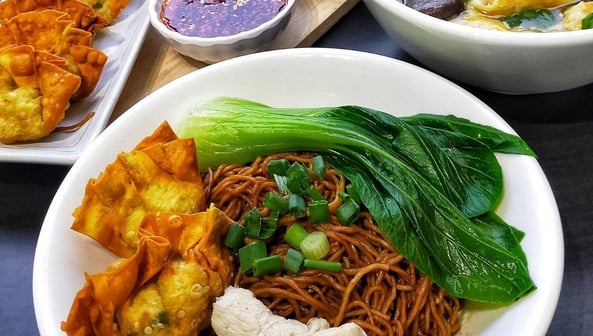

Mee Wantan
RECIPES
HISTORY
Mee Wantan
Wantan noodles (or Wantan Mee) is a popular noodle dish originating from the Chinese community, particularly the Cantonese, and is very popular in Malaysia, Singapore, and Hong Kong. It combines fine egg noodles, soy sauce or soup, and wantan (meat-filled dumplings). Wantan noodles originated in Southern China, particularly Guangdong (Cantonese), and have been around since the Tang Dynasty. In their original version in Hong Kong, they were usually served in a hot soup with shrimp and pork. When Chinese people migrated to Southeast Asia in the 19th century, they brought this recipe with them and adapted it to local ingredients and tastes. In Malaysia, especially in states such as Penang, KL, Johor, and Ipoh.
Main ingredients
300g egg noodles (wantan noodles) – soaked for a while
Green mustard – soaked
Minced chicken or minced shrimp filling – for the wantan filling
Wantan skin (can be bought ready-made at the supermarket)
Wantan filling:
150g finely chopped chicken
1 teaspoon sesame oil
1 teaspoon light soy sauce
A pinch of pepper & salt
Sauce Ingredients (for dry version)
1 tablespoon sweet soy sauce
1 tablespoon salty soy sauce
1 teaspoon sesame oil
1 tablespoon garlic oil (or regular oil)
A little vinegar (if you like it sour)
Soup Ingredients (for wantan/soup):
3 cups chicken or anchovy broth
2 cloves garlic – crushed
A pinch of pepper and salt
Instructions
Wontons:
Boil water until boiling.
Add wrapped wontons and boil for 3–4 minutes until they float.
Remove and drain.
Noodles & Mustard:
Boil egg noodles in boiling water for 1–2 minutes. Drain and mix with a little sesame oil.
Also, blanch the mustard greens, remove and drain.
Prepare Soup (if desired):
Boil water with garlic, a little pepper and salt.
Add the remaining water from boiling the wontons for more flavor.
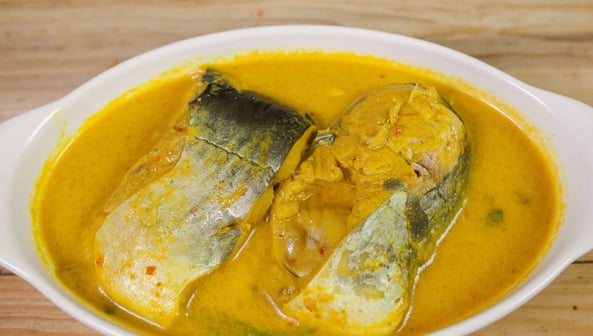

Gulai Tempoyak Ikan Patin
RECIPES
HISTORY
Gulai Tempoyak Ikan Patin
Patin is a freshwater fish from the Pahang River. Its flesh is soft, fatty and does not have many small bones, making it a prime choice in various traditional dishes. Tempoyak is the fermentation of durian flesh, a traditional Malay practice as a way to preserve seasonal fruits for use throughout the year. The combination of these two ingredients produces a unique dish that is not authentically found in other states. Tempoyak gulai is a main dish in feasts, social gatherings, and also the daily food of the Pahang people.
Main ingredients
1 catfish (halved and cut into serving size)
3-4 tablespoons durian paste
2 lemongrass stalks (sliced)
3 turmeric leaves (shredded or chopped)
Salt and sugar to taste
Enough water (approximately 2-3 cups)
Ground ingredients
10-15 chilies (can add more if you like it spicy)
3 cloves shallot
2 cloves garlic
1 inch fresh turmeric (or 1 teaspoon turmeric powder if not available)
Instructions
Blend the ingredients until smooth.
Add the blended ingredients to the pot with the tempoyak, lemongrass, and water. Stir well.
Bring the sauce to a boil over medium heat. When boiling, add the catfish.
Add the turmeric leaves, salt, and a little sugar.
Cook until the fish is tender (about 10–15 minutes only).
Taste the sauce – balance the sourness, spiciness, and fat according to taste.
Ready to serve – delicious with hot rice and side dishes.
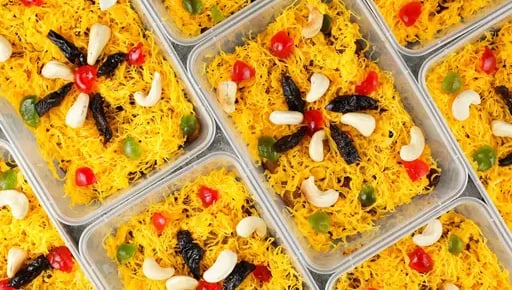

Puding Raja
RECIPES
HISTORY
Puding Raja
Puding Raja (or Puding Diraja) is a special dessert originating from the state of Pahang, and is one of the symbols of luxury in Malay royal cuisine. It was known as a dessert of the nobility and royal family in ancient times, but is now enjoyed by all levels of society, especially during festive seasons or special occasions.
Main ingredients
Sweet plantains (small, fried or steamed)
Golden net (made from finely cooked egg yolks like sweet noodles)
Prunes / dried cherries / figs
Roasted almonds / cashews
Custard sauce (based on milk, eggs and custard powder)
Instructions
Sweet bananas are arranged in a bowl or serving plate.
Decorated with prunes, cherries, and nuts.
Gold mesh is placed on top as the main decoration and symbol of luxury.
A thick and sweet custard sauce is poured over the top when it is ready to be served, adding a rich and cool flavor to this pudding.
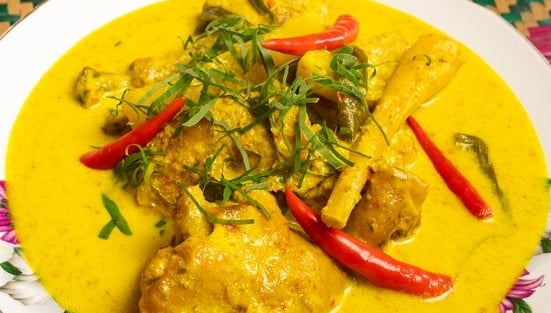

Masak Lemak Cili Api
RECIPES
HISTORY
Masak Lemak Cili Api
Masak Lemak Cili Api is the most famous dish from Negeri Sembilan, and has become the main symbol of Minangkabau-Malay cuisine in Malaysia. The specialty of this dish is its biting spicy taste, coconut milk fat, and the use of live turmeric and chili padi without onions, making it different from other negeri lemak dishes.
Main ingredients
500g smoked meat / village chicken / smoked duck / shrimp / catfish
3 cups of thick coconut milk
2 lemongrass sticks (dotted)
2 leaves of turmeric (shredded)
Salt to taste
Ingredients for the puree:
20–25 local chilies (depending on the level of spiciness)
1 inch fresh turmeric
Instructions
Mash the chilies and turmeric until smooth. Do not grind – puree is more natural and thick.
Add the mashed ingredients to the pot with the thick coconut milk, lemongrass and smoked meat.
Cook over low heat while stirring gently so that the coconut milk does not break.
Add turmeric leaves and salt to taste.
Let simmer until the gravy thickens and the meat is tender (if the meat has not been cooked before).
Ready to serve! Best eaten with hot rice and side dishes.
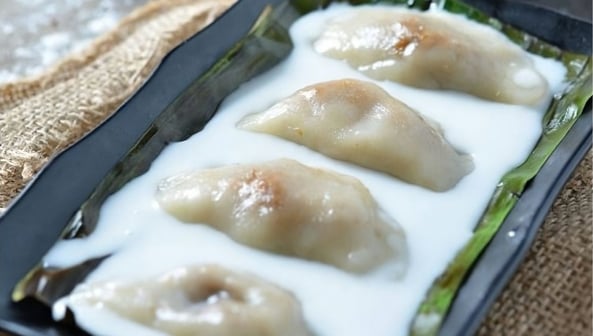

KUIH SOPANG
RECIPES
HISTORY
KUIH SOPANG
Kuih sopang is famous among the traditional community of Negeri Sembilan, especially in the interior. It is made from black glutinous rice, filled with sweet coconut filling, and cooked by steaming in banana leaves. The name “sopang” is believed to come from the local pronunciation or Minangkabau dialect, but its meaning is now better known as the name of the cake itself. This cake symbolizes the delicacy of the hands of elders and symbolizes the value of cooperation in its preparation, as it is usually made in a cooperative manner.
Main ingredients
For the dough:
2 cups black glutinous rice – soaked overnight, drained
A little salt water
Banana leaves – rolled to soften (for wrapping)
For the filling:
1 ½ cups grated white coconut
½ cup gula melaka (finely chopped or grated)
2 tablespoons granulated sugar (to taste)
1 pandan leaf – tied
A little water
Instructions
Cook the gula melaka, granulated sugar and a little water in a pan until dissolved.
Add the grated coconut and pandan leaves.
Cook until slightly dry and thick. Cool.
Cake:
1. Take a little black glutinous rice and flatten it on your wet hands.
2. Place a little coconut filling, then cover and shape into a round or oval shape.
3. Wrap with banana leaves, usually shaped like a lepat – a triangular or cylindrical fold.
4. Steam for about 20–30 minutes until the glutinous rice is cooked.
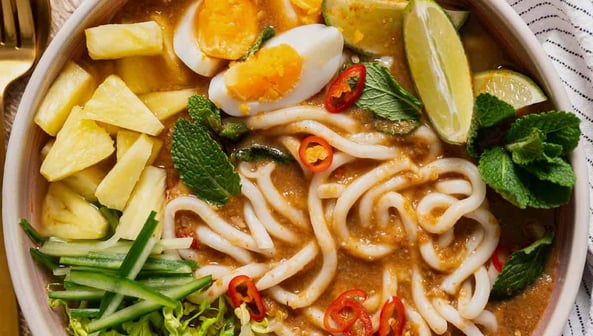

Laksa Perak
RECIPES
HISTORY
Perak laksa
Perak laksa, especially from Kuala Kangsar, is one of the traditional dishes that the people of the state love. Different from Penang laksa which is thick and full of spices, Perak laksa is lighter, based on boiled fish, and has a thinner but refreshing broth.
Main ingredients
Gravy:
• 5–6 fresh mackerel / sardines
• 1 large onion
• 2–3 cloves garlic
• 1 inch ginger
• 1–2 pieces of asam gelugor
• Enough water for gravy
• Salt and sugar to taste
Laksa & Ulam:
• Rice Laksa (fine or coarse type, boiled until soft)
• Cucumber (finely sliced)
• Bean sprouts
• Onion (sliced)
• Fresh kesum leaves
• Lettuce leaves / ulam raja (if you like)
• Boiled egg (halved)
• Red chili or sambal belacan (as a flavor enhancer)
Instructions
1. Boil the fish until cooked. Separate the meat and discard the bones. Save the cooking water for the gravy.
2. Grind the fish meat with the onion, garlic, and ginger until smooth.
3. Add the ground ingredients to the pot with the fish cooking water, asam gelugor, salt, and sugar.
4. Cook the gravy until boiling and season.
5. In a bowl, place the boiled laksa. Add the ulam, sliced vegetables, and boiled eggs.
6. Pour the hot gravy over the laksa. Serve with sambal belacan if you want it spicier.
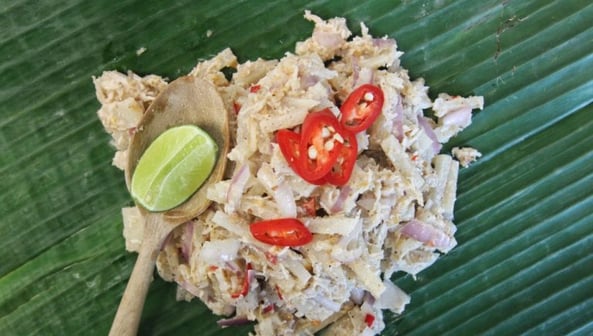

Kerabu Umbut Bayas
RECIPES
HISTORY
Kerabu Umbut Bayas
The bayas tree (also known as Arenga westerhoutii or a type of wild palm) grows in tropical regions, especially in the forests of Perak and Kedah. The umbut is the soft part in the middle of the tree trunk – very valuable because it is difficult to obtain (only one tree can produce a small amount). This kerabu is prepared in the traditional way, mixed with grated coconut, chilies, lime, and other ingredients creating a balanced taste of sweet, sour, spicy and fatty. Popular at village feasts and formal occasions that celebrate the heritage of traditional Orang Asli and Malay food.
Main ingredients
• 1 cup bay leaf (finely sliced after boiling)
• ½ cup grated coconut (roasted until brown)
• 2 tablespoons fried anchovies (coarsely crushed – optional)
• 5 red/green chilies (finely sliced)
• 1 large onion (sliced)
• Squeeze of lime or kasturi lime
• A pinch of salt and sugar
Instructions
1. Boil the bay leaves until tender, then slice finely or slice lengthwise like large bean sprouts.
2. Mix in a large bowl with the coconut milk, chili, anchovies, and onion.
3. Mix well with lime juice, salt, and a little sugar.
4. Ready to serve as a side dish or appetizer.
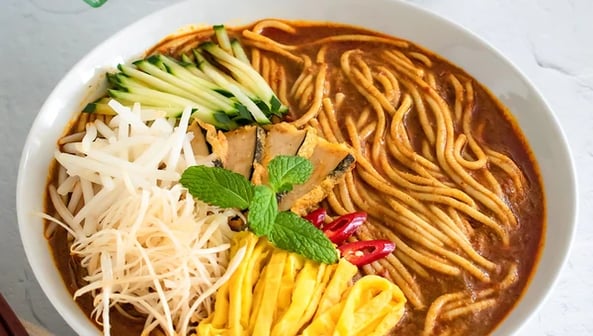

Laksa Sarawak
RECIPES
HISTORY
Laksa Sarawak
Laksa Sarawak is one of the traditional dishes that is very popular in the state of Sarawak, Malaysia. It is different from other laksa in Malaysia such as Laksa Penang or Laksa Johor. The origins of this laksa are believed to come from the influence of Chinese and local Peranakan culture, where it first became known around the early 20th century in Kuching, Sarawak. One of the famous laksa paste brands in Sarawak is Swallow Brand (Cap Burung Layang), which has been used since the 1960s and is still the main choice of many until now. Laksa Sarawak has become a culinary icon of Sarawak and is often made a must-try menu for tourists.
Main ingredients
Gravy
• 1 packet of Sarawak laksa paste (for example: Swallow Brand)
• 2 litres of water
• 500ml of coconut milk (can be added according to the desired consistency of the gravy)
• 2-3 tablespoons of cooking oil (for frying the laksa paste)
• Salt and sugar to taste
• A little boiled chicken or prawns (for extra flavour)
• Ingredients for Garnish / Serving:
• Rice noodles (vermicelli) – blanched and tossed
• Chicken fillet – boiled and finely chopped
• Prawns – boiled and peeled
• Eggs – made into thin omelettes and finely sliced
• Bean sprouts – blanched briefly
• Coriander leaves or soup leaves – chopped
• Musk lime – cut in half
• Sambal belacan – as a flavour enhancer
Instructions
How to Cook Sarawak Laksa
Stir-fry the Laksa Paste
• Heat the oil in a large pot, then stir-fry the laksa paste until fragrant and slightly crisp.
Boiling the Gravy:
• Add water to the stir-fried paste and stir until combined.
• Let it boil and then add the coconut milk.
• Add a little salt and sugar to taste.
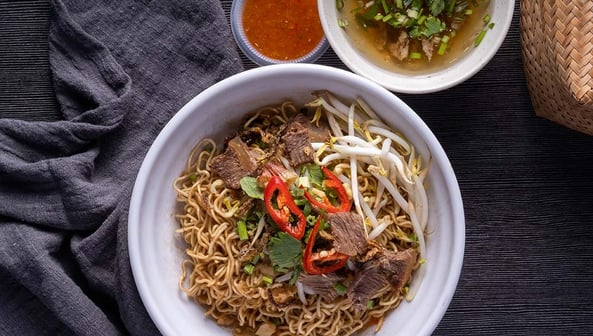

Mee Kolok
RECIPES
HISTORY
Mee Kolok
Mee Kolok is one of the iconic dishes from Sarawak, especially popular in Kuching. This dish is usually eaten for breakfast, but is also popular throughout the day. Mee kolok is known for its chewy and non-greasy noodles, and its mild but rich flavor. Mee kolok is believed to have originated from the Sarawakian Chinese community, especially the Hakka and Foochow, who have settled in Sarawak since the early 20th century. It has been adapted to local tastes and is now a favorite food of various ethnic groups in Sarawak including the Malays, Ibans and Bidayuhs with halal variations using chicken or beef.
Main ingredients
For the noodles:
• 300g kolok noodles (you can also use egg noodles or local yellow noodles)
• Hot water (for soaking the noodles)
For Chicken/Beef Marinade:
• 200g chicken or beef (thinly sliced)
• 1 tbsp sweet soy sauce
• 1 tbsp salty soy sauce
• 1/2 tsp white pepper
• 1 tsp sesame oil
For the Noodle Mixing Sauce:
• 1 tbsp light soy sauce
• 1 tbsp garlic oil (see below)
• 1 tsp sesame oil
• 1 tsp vinegar (if you want a slightly sour taste)
• A pinch of salt/white pepper (to taste)
Garlic Oil:
• 3 cloves garlic (finely chopped)
• 4 tbsp cooking oil
Instructions
How to Cook Kolok Noodles:
• Blanch the kolok noodles in hot water for 1-2 minutes until soft. Drain and rinse with cold water to stop the cooking process. Drain again.
• Sauté the chopped garlic in oil until golden brown. Keep the oil and onion separate.
• Marinate the meat for 15-30 minutes. Then fry or sauté until cooked and set aside.
• In a bowl, mix the mixing sauce (soy sauce, sesame oil, garlic oil, a little salt/pepper). Add the noodles and mix well.
• Place the noodles on a plate, arrange the meat on top, and sprinkle with spring onions and fried onions. Can be served with clear soup.
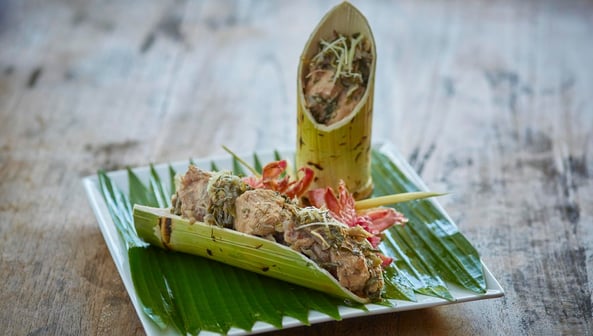

Manok pansoh
RECIPES
HISTORY
Manok pansoh
Manok Pansoh is a traditional dish of the Dayak people (Iban, Bidayuh, and Orang Ulu) in Sarawak, Malaysia. This dish is unique because it is cooked in bamboo, which gives the dish a natural aroma. “Manok” means chicken in the Iban/Bidayuh language, and “pansoh” means cooked in bamboo. This dish comes from the culture of the indigenous people of Sarawak, who traditionally cook using natural ingredients such as bamboo, leaves, and wood fire. This technique not only preserves the original flavor of the ingredients, but also allows them to cook while in the jungle without a crock pot.
Main ingredients
Manok Pansoh Ingredients
• 1 medium village chicken (cut into small pieces)
• 2 lemongrass stalks (scored)
• 5–6 shallots (coarsely crushed)
• 3 garlic cloves (coarsely crushed)
• 1 inch ginger (finely sliced)
• 1 inch galangal (finely sliced)
• 1 inch fresh turmeric (crushed or sliced)
• 3–4 chilies (depending on the level of spiciness)
• Turmeric leaves (1 piece, chopped)
• Bungkang leaves or ubi leaves (if you like)
• Salt to taste
• Enough water (to moisten the ingredients)
• Young bamboo (clean and about 2–3 feet long)
Instructions
1. Prepare the ingredients:
• Mix the chicken with all the ingredients: onion, ginger, galangal, turmeric, chili, lemongrass, turmeric leaves and salt. Mix well. You can also marinate for 30 minutes for the flavor to penetrate more.
2. Stuff into the bamboo:
• Put the chicken mixture into the young bamboo. Add a little water (just enough to moisten, not too much).
3. Cover the mouth of the bamboo:
• Cover with banana leaves or yam leaves to prevent steam from escaping.
4. Grill in the fire:
• Place the bamboo on the edge of a campfire or embers (not directly in the fire). Grill the bamboo slowly for 45–60 minutes. Turn the bamboo so that the cooking is even.
5. Ready to serve:
• When cooked, tap the bamboo to remove the chicken. Serve hot with rice or boiled cassava.
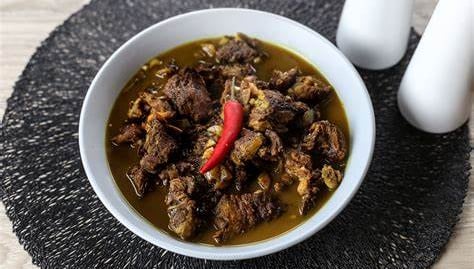

Manok pansoh
RECIPES
HISTORY
Tiulaitum
Tiulaitum is a traditional food of the Papuan people, especially from tribes living in mountainous areas such as the Dani tribe. The name "Tiulaitum" comes from the local language which refers to food cooked using leaves and tubers, usually with the stone-baking technique, a traditional cooking method that is very unique and special in Papua. This food is often cooked en masse during important events such as traditional ceremonies, harvest festivals, or welcoming guests.
Main ingredients
• Yam leaves or yam leaves (for wrapping the ingredients)
• Sweet potatoes (the main tuber in Papua)
• Yams
• Cassava (cassava)
• Pork (can be replaced with chicken or fish)
• Banana leaves or taro leaves (for the outer layer)
• Local vegetables (such as fern leaves or young papaya leaves)
• Salt and natural seasonings
Instructions
How to Cook Tiulaitum (Traditional Method – Stone Baking)
Prepare a hole in the ground
· A hole is dug in the ground and stones are placed and heated over a high heat.
Prepare the ingredients
· All ingredients such as meat, tubers, and vegetables are cut into small pieces.
Arrange the ingredients in layers
· In the hole, hot stones are arranged at the bottom. Then layers of leaves, meat, tubers, and vegetables are arranged.
Cover and let cook
· Once all the ingredients are arranged, they are covered with banana leaves and soil to trap heat. Let cook for 2–3 hours.
Ready to eat
· Once cooked, the ingredients are opened and served to share.
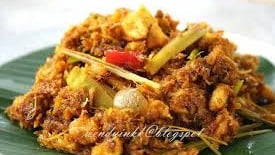

SINAGOL
RECIPES
HISTORY
SINAGOL
Sinagol is another traditional dish from Sabah, especially from the Bajau community and also the Kadazan-Dusun in some areas. It is known as a traditional food based on fish and coconut milk, and is very popular among the people living on the coast of Sabah. Sinagol originated from the Bajau community who live in coastal areas such as Kota Belud, Semporna, and Lahad Datu. It is a heritage dish that combines fresh fish, grated coconut, and aromatic ingredients, and is usually eaten with rice. It is also popular among the Kadazan-Dusun who live in areas near the sea, and is sometimes known by different names depending on the district.
Main ingredients
Main Ingredients of Sinagol
• Fresh fish (usually cod, mackerel, or basung fish)
• Grated coconut (which has been squeezed to obtain coconut milk)
• Lemongrass – finely chopped or sliced
• Raw turmeric – pounded or ground
• Onion & garlic
• Ginger
• Chili (to taste)
• Tamarind or lime juice (for sour taste)
• Salt and a little seasoning (if necessary)
Instructions
How to Cook Sinagol
• Clean the fish, cut into several pieces.
• Mash or grind ingredients such as turmeric, onion, ginger, and chili until smooth.
• In a wok, add the mashed ingredients with a little oil and sauté until fragrant.
• Add the fish and mix well with the sautéed ingredients.
• Pour in the coconut milk and add lemongrass and asam keping.
• Cook over medium heat until the sauce boils and the fish is fully cooked.
• Season with salt and a little seasoning if desired.
• Serve hot with white rice.













Location
1 . Nasi Daging Warisan, Sungai Petani,Kedah
3 . Restorans Siti Fatimah
2 . Ikan Pekasam Kak Nah



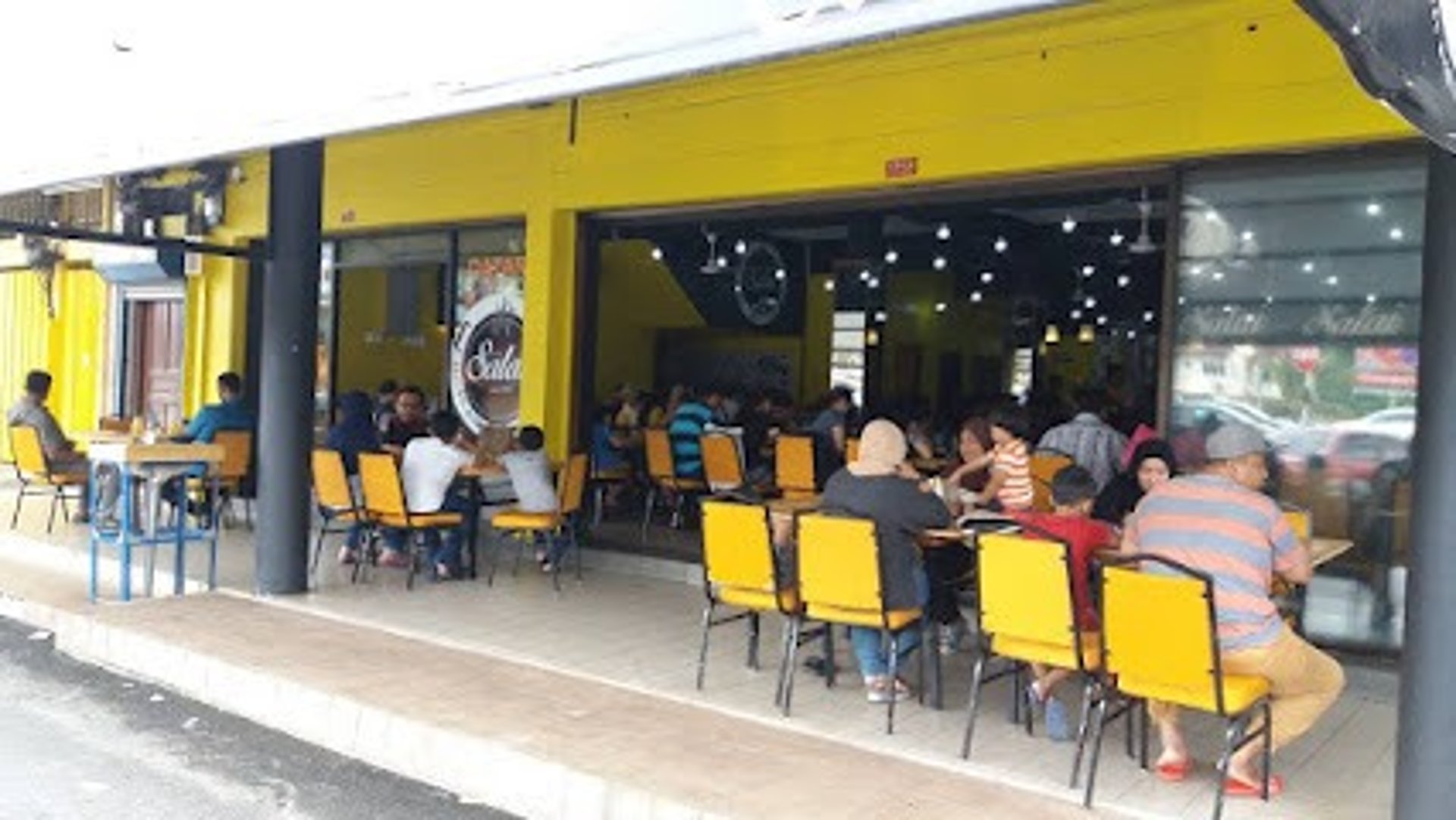





Location
1 . Restoran Selera Nasi Beringin
3 . Mee Bandung Abu Bakar Hanipah
2 . Mee Siput Kak Chik



